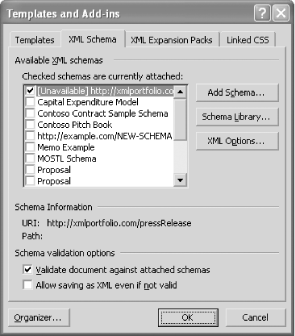4.7 Attaching Schemas to a Document
| A given WordprocessingML document can have one or more schemas "attached" to it. The purpose of schema attachment is to enable two things:
Schema validation happens automatically as a user edits the document. If a particular element declared in an attached schema is present in the document and does not conform to the type defined in the schema, then Word will flag this as an error. We've seen examples of this in our press release example, for certain simple types such as xsd:date. Schema-driven editing functionality is exposed through the XML Structure task pane (covered below) and the Document Actions task pane (covered in Chapter 5). The Word UI allows you to manually attach schemas to the currently open document. Figure 4-17 shows the appropriate dialog, which you can access by selecting Tools Figure 4-17. Manually attaching an XML schema to a document The "Available XML schemas" list contains the aliases for all of the schemas in the schema library. In this example, the Press Release checkbox is checked, which means that the press release schema is attached to the current document. Multiple schemas can be attached to the same document, just as elements from multiple namespaces can be used in the same XML document. The Add Schema... button lets you browse for an XSD schema document file in order to add it to your machine's schema library. By default, it also attaches the schema to the document automatically checking the corresponding checkbox that newly appears in the "Available XML schemas" list. The Schema Library button opens the Schema Library dialog, which we looked at earlier. 4.7.1 Demystifying Schema AttachmentIf all you ever do is manually attach schemas through the Word UI, the process of "schema attachment" may seem a little mysterious. The first thing to do is to stop thinking of it as a process. Instead, think of it as a property of the underlying WordprocessingML document. Secondly, it's important to understand that Word treats namespaces and schemas as virtually synonymous. That a "schema is attached" to a document means nothing more than the fact that a non-WordprocessingML namespace declaration is present somewhere inside the WordprocessingML document. A "non-WordprocessingML namespace declaration" is a declaration for any namespace other than the namespaces reserved for Word that were introduced in Chapter 2. So when Word says that a schema is attached to a document, it really means that a namespace is attached. The fact that a schema is attached to the document is independent of whether a corresponding schema library entry is present on the current user's machine. It doesn't even matter if the document contains an element or attribute that uses the namespace. Example 4-6 shows a simple WordprocessingML document with a schema attached, i.e., with a namespace declaration that is not among one of Word's reserved namespaces. Example 4-6. A WordprocessingML document with a "schema attached"<?xml version="1.0"?> <?mso-application prog?> <w:wordDocument xmlns:w="http://schemas.microsoft.com/office/word/2003/wordml" xmlns:foo="http://xmlportfolio.com/pressRelease"> <w:body/> </w:wordDocument>If someone in our imaginary PR department opened this document in Word and selected Tools What happens if the user doesn't have a corresponding schema library entry? In that case, the schema is no less attached, because we've defined "schema attachment" as the presence of a non-WordprocessingML namespace declaration. However, in this case, the attached schema would be considered "unavailable." Figure 4-18 shows how the Word UI handles this scenario. Figure 4-18. An attached, but unavailable, schema As you can see, a checkbox is still checked, meaning that "a schema is attached." The only difference is that, since there is no corresponding schema library entry, this schema is considered to be "Unavailable." And without a corresponding XSD schema document, schema validation and schema-driven editing are not possible. Thus, for schema validation to work correctly, two conditions must hold:
Now let's relate all of this back to our primary use case using Word as an XML editor. If you recall the basic processing model, the first thing that happens when Word opens an arbitrary XML document is that an XSLT stylesheet is applied to it, converting it to WordprocessingML. Even though the schema library is consulted to see which XSLT stylesheet to apply (based on the namespace of the document's root element), no schemas have been attached at this point. Whether a schema is ultimately attached to the document that the user edits is completely determined by whether the result of the onload XSLT transformation includes any non-WordprocessingML namespace declarations. Of course, if the result document contains any custom XML elements in your schema's namespace, then the schema will de facto be attached (because you can't have an element without declaring its namespace). And since schema validation is usually only useful when custom XML elements are already present, schema attachment is usually an automatic thing you don't have to think about; it just happens. Even so, understanding how it works is helpful for debugging and for explaining where unwanted "unavailable" schemas come from namely, wayward namespace declarations in the result of the onload transformation. (The onload XSLT stylesheets will therefore often use the exclude-result-prefixes and extension-element-prefixes attributes to prevent unwanted namespace declarations appearing in the WordprocessingML document.) |
EAN: 2147483647
Pages: 135
 Templates and Add-Ins
Templates and Add-Ins